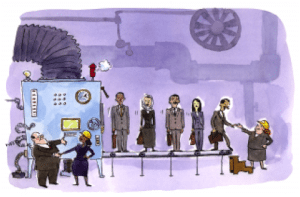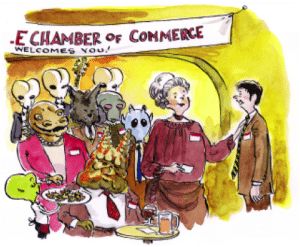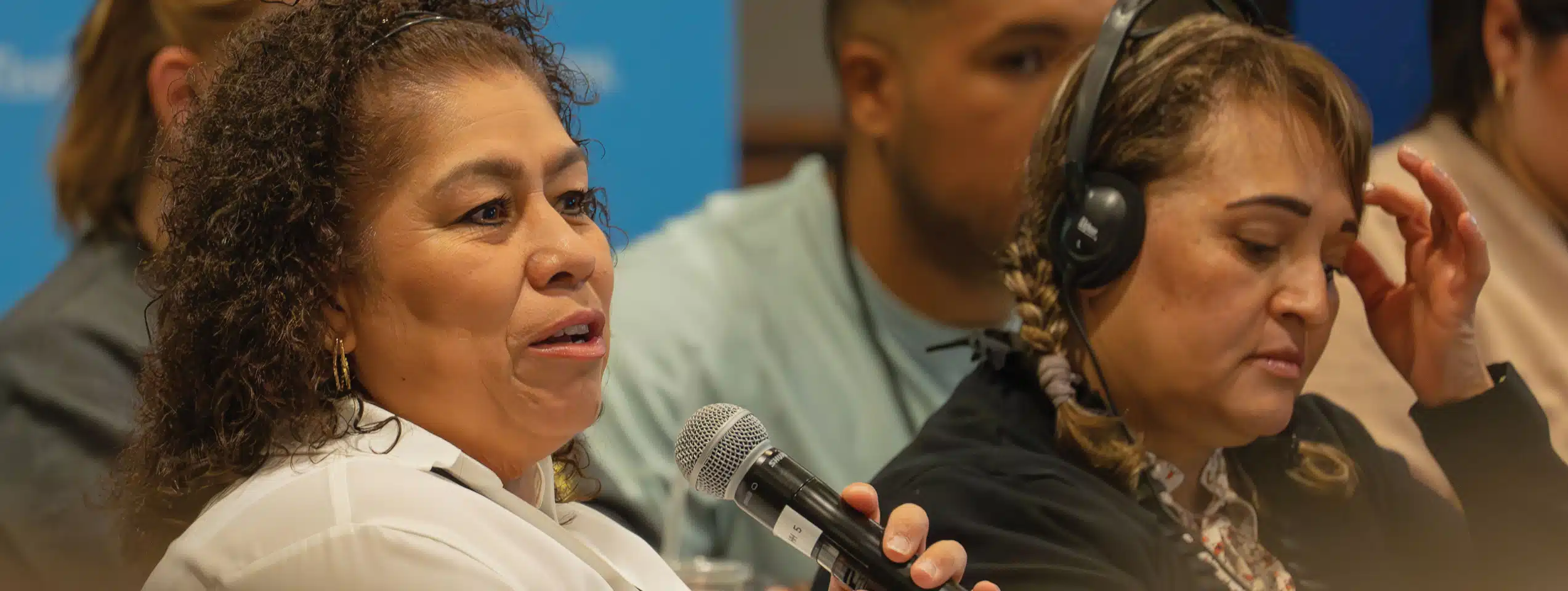
Travel to the future – and back – to see why harnessing our demographic shifts and increasing the level of minority business ownership might be crucial to the future of the Kansas economy.
Bear with me for a second. I’m going to give you a glimpse of the future.
This collection of letters and symbols might look like a magazine article.
But it’s actually a magic time machine.
Let me reattach a few levers and adjust the flux capacitor a little bit.
Boom. It’s the future.
That’s 2050 to be exact, a leap of 35 years. We’re standing together at 325 East Douglas in Wichita, just outside the current location of the Kansas Leadership Center and Kansas Health Foundation Conference Center, which feels both hauntingly familiar and strangely changed. I’ll give you just a moment to get your bearings.
We didn’t come to Kansas in 2050 to see whether we finally have flying cars. Our mission today is to try to understand the state’s economic future. I must warn you: It could turn out to be a bit of a wake-up call.
At first glance, it might be surprising how recognizable Kansas is in 2050. What’s really different, though, might not be noticeable at first, unless you’re a demographer.
The America that Kansas sits in has changed. It’s a vastly more competitive world, but we’re still a major economic world power. There are 100 million more people living in the U.S. than in the time we just came from, more than 400 million people in all. Kansas is more populous, too.
It might be hard to spot from this busy street corner, but one big change that has occurred is that as a Caucasian, I’m a minority in this country. People who look like me, non-Hispanic whites, still make up the largest population group in the U.S., but now there are more people, combined, who are Hispanic, black, Asian or American Indian/Alaska Native. Plus, more people now straddle multiple races, ethnicities and identities.
The changes in Kansas might not be quite as big as they are nationally. But they’re here. And if I took you from the street corner on a tour, community by community, it would likely be hard to find a place that hasn’t been touched by these demographic shifts.
We’re a long way from the 1900s, or even the 1970s, when more than 90 percent of the people who called Kansas home were white. Our economy here is humming along better than ever. Kansans have higher per capita incomes. Things are far from perfect, but these are good times. A lot of factors went into this surge, but one of the most important is people. Residents put their focus on people and developing their abilities to bring their business ideas to fruition, impacting the economy for the better.
People from across the state – governors, state lawmakers, local-government officials, businesses, banks, chambers of commerce, economic development officials and community groups – foresaw the demographic changes. They upped their emphasis on a high-quality education for all Kansans.
They recognized the role that promoting more entrepreneurship and business ownership could
have in invigorating our economy. And they made the decision that one of strategies for bolstering our economy would be to foster the growth of minority-owned businesses.
A Critical Asset
I’m sure it wasn’t an easy decision. There must have been doubters and dissenters, many of whom had some really great points. And there were countless barriers to explore and try to overcome. But there were a lot of reasons it made sense, too. The data we had 35 years ago told us that minorities were significantly underrepresented as businesses owners in Kansas. These statistics served as a warning that something was wrong and needed to be addressed.
Taken together, information showed that minorities would play an even larger role in our economic success. First-generation immigrants wanted to start businesses at a higher rate than nonimmigrants, so encouraging them to create businesses represented a leverage point. Data showing the U.S. economy becoming less entrepreneurial over time reinforced the need to foster increased dynamism in the state’s economy.
Faced with all that, government, business and nonprofit sectors made some clearly-thought-out, strategic decisions. They knocked down barriers to financing. Mentorship programs were started to help build capacity. Kansans recognized how important a resource people are for powering economies with their ideas and risk-taking. They understood that smart, talented people like to cluster around other smart people pursuing the same interests. They wondered if bolstering minority-owned businesses could give the state a competitive advantage in the global economy. They mulled over whether increasing minority business ownership represented a “low hanging fruit” approach to bolstering the Kansas economy.
Their efforts didn’t come with a lot of guarantees. But over time, the rates of immigrants starting new businesses in Kansas ticked up. Places such as Wichita tapped into a wealth of know-how and innovation in manufacturing to reinvigorate that sector. A number of these new businesses were started by minorities. As the ranks of minority-owned firms grew across the state, they also mostly grew in the right places, limiting the displacement of existing businesses, particularly in the service industry. More and more minority business owners starting firms worked to tap into the global economy by exporting their goods, helping build the state’s export power.
It’s always hard to attribute economic changes to any one strategy, but there’s a widespread belief in 2050 that Kansas has a more dynamic economy at least in some part because of the increase in minority-owned businesses seen over the previous 35 years.
But you don’t need a time machine to see this future on the horizon. Author Joel Kotkin, Distinguished Presidential Fellow in Urban Futures at Chapman University in California, penned a book in 2010 that described an economically surging future America fueled by immigration and entrepreneurship, and featuring a period of renewal for Great Plains states such as Kansas.
“The Heartland offers the country an outlet for the entrepreneurial and creative skills of its rising population,” Kotkin writes. “It will offer millions the chance to enjoy more spacious, less congested, and more healthful lives than can be found or easily afforded in the largest cities. No longer geographically isolated or cut off from vital information, the Heartland is one of America’s critical assets as it prepares to accommodate the next hundred million.”
All this, of course, hasn’t happened yet. It’s just one potential timeline for the future. An aspiration, really.
The choices we make here in 2015 and beyond will play a role in whether this future actually happens. To get a sense of where this more prosperous future could start, we’ll have to hop back in the time machine. We’ll be leaving 2050 behind – or is that ahead? I’ve set the dial for August 13, 2014.
What Makes For a Good Economy?
Just up the main staircase and to the right in KLC’s building is the High Plains classroom, where 35 stakeholders have gathered to discuss the state of minority-owned business. It’s a diverse group of people from a variety of different sectors: government, business, finance and the community. Sitting at the front of the room are three economists, Donna Ginther of the University of Kansas; Jeremy Hill of Wichita State University; and Rob Catlett of Emporia State University. Ed O’Malley, KLC’s president and CEO, is moderating the panel. Wayne Bell, district director for the Wichita office of the U.S. Small Business Administration and someone who has tried to bring a lot of attention to the need for more minority-owned businesses in Kansas, speaks as well.
Now that we’ve seen the aspiration for the future, we’ll be exploring our less-than-ideal current reality. Some pretty stark statistics illustrate the gap. Minorities accounted for just 7.7 percent of the state’s business owners last decade, even though nonwhites and
Hispanics made up nearly 23 percent of the state’s population. It’s hard to come up with any justifiable reasons for this situation. While no state reaches parity, Kansas fares worse than most, ranking 42nd. More diverse states tend to fare better in terms of minority business ownership parity. But Kansas trails nearly a dozen other states with less diverse populations.
It’s certainly hard to argue against the social value of having more minority-owned businesses in Kansas. But the question before the group that day hinged on economics. Would increasing the number of minority-owned businesses in Kansas actually improve the state’s economy?
What looks clear from the vantage point of our imagined 2050 feels fuzzier in this room. To help us understand things better, Hill, Ginther and Catlett– economists and experts – explain just what we know about making an economy hum.
Some high-level takeaways for those who snoozed through econ: People are really important, both in terms of having a growing population and having well-educated people with strong skills. Universities can fuel innovation, but Kansas currently lags in patents. Tax policies can help but generally take awhile to have a “real economic impact.” Increasing exports, particularly in the already established manufacturing sector, and having people in other countries increase the level they are investing and owning companies here can make a big difference.
Jobs often grab the headlines, but per capita income might be a better measuring stick. And wealth, too. If you look at the wealthiest states, Catlett of Emporia State says, you’ll find “extremely, extremely high levels of education in terms of their work force.” That means increasing levels of educational attainment would be important for the Kansas economy.
Perception matters, too. Firms looking at the state need to know that Kansas has a qualified workforce to employ and is a good place to locate a business. “When you talk to companies, they have a very difficult time because of this negative image of the state,” says Hill, director of the Center for Economic Development and Business Research at WSU. “So specific for us is a strategy of really changing and giving resources that say, ‘Here’s why you really do want to come here.’”
The state can also derive economic benefits, Catlett says, from the clustering of companies and talent operating in the same sector near the same location. Whether it’s Hollywood, Silicon Valley or the aerospace industry, the pull to be among firms and talented people working in the same field is a strong one.

Pitfalls Along the Way
The promises for Kansas in increasing the ranks of minority-owned businesses lie in harnessing factors that we already know help create economic growth.
The simplistic formula could look something like this: Cultivate more minority-owned businesses in sectors already rooted in Kansas that have growth potential, especially ones with the potential to increase their exports, such as Wichita’s manufacturing sector. Provide high-quality education for children from early childhood on. Increase levels of educational attainment, particularly in minority communities. Mentor prospective business owners and foster business-ownership skills early on. Encourage the development of succession plans that allow minority owners to keep established businesses alive. Clear away structural barriers to financing and government contracting. Make the state a magnet for smart, skilled people who have great business ideas – whether they were born here or not – and find ways to encourage them to bring those concepts to reality.
But the devil, as they say, is in the details.
“As a strategy, it’s a new one,” says Ginther, director of the Center for Science, Technology & Economic Policy at KU’s Institute for Policy & Social Research. “There’s a short-term version of it, which is working with businesses and people right now. And there’s a longer term version in terms of creating an infrastructure through the state so that (more minorities) have the capacity and potential to be entrepreneurs.”
There are pitfalls, too. As Hill points out, it matters what sectors minority-owned businesses are located in. The largest number of existing minority-owned businesses in Kansas are located in support sectors and “may not be necessarily creating new wealth to a regional economy,” Hill says. A given area can only support so many service businesses. Increase minority business ownership as currently structured in Kansas with a wave of a wand, Hill says, and you’re likelyto displace other businesses, both minority- and nonminority-owned.
Furthermore, as Ginther explains, not everybody is suited to be a business owner. Entrepreneurship by its very definition involves assuming risk and courting failure, and not everybody has the skills, disposition or interest in bringing a business concept to market or managing an existing business. And while increasing business ownership is a leverage point, it’s also important to recognize the role that larger, more established firms play in increasing employment and paying higher wages. Don’t expect to find a magic economic bullet.
There are also plenty of unknowns.
As our state delves into the issue, we’re only beginning to discover just what the barriers to minority business ownership actually are. Some of the barriers might be as much about perception as structure. We’ll have to get to the bottom of why these barriers – both real and perceived – exist and try to counteract them.
For instance, many banks in Kansas don’t see a lot of minority applicants for business financing. They simply don’t come in or take the final steps. Bankers make decisions, as one participant in the meeting stated, based on the five C’s of credit, including capacity, capital, collateral and conditions. But one of those C’s, character, is subjective. It’s judged by having someone sit down for a talk with you. To prosper, we’ll need more minorities who can look past the stereotype of the “stodgy conservative banker” and take the risk of seeking out financing for their businesses. And we’ll need lenders who’ll actively work to create climates to attract qualified applicants from any cultural or ethnic background.
As with many complex adaptive challenges facing Kansas, we can only address the problem by learning along the way as we try to solve it. Which makes it hard to know how we’ll get from Point A – where we are now – to Point B, that vibrant economic future I gave you a glimpse of earlier.
What we have right now is a lot of questions. Foremost among them: Do we have the will to advance this issue in the service of the state’s economy? Because changing the status quo will require engagement not only among minority communities, but also among many who are neither minorities nor business owners who might not see yet how change benefits them.
How far exactly are we willing to expand our circles of concern to act in making the Kansas economy more vibrant?
It’s a deep question even our magic time machine cannot answer. As residents of this state, we’re the ones who must respond to it.
A future that’s sure to be influenced by changing demographics lies ahead. And there’s enormous potential for increased economic opportunity lying just over the horizon, if we can harness these demographic shifts to benefit the common good.
What shall we do next?


